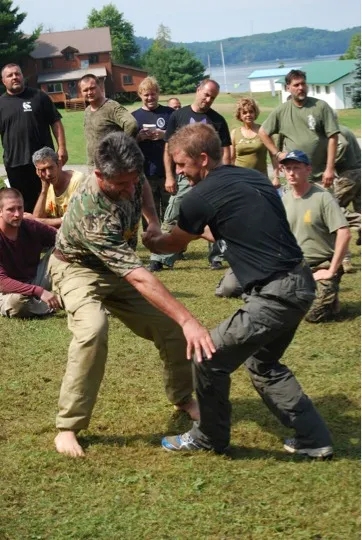

I had a great visit to The System Academy in Wiltshire last week where I enjoyed a bit of 1-1 Systema coaching from my old friend and owner of the Academy, Matt Hill. I also recorded a podcast episode with him for The Tai Chi Notebook Podcast, which will be coming out in November. Matt trained Aikido in Japan and served as a Captain in the British army, as well as working in crisis management before he became a full time Systema instructor, so he’s got a lot of experience of different types of martial arts and working in pressure scenarios. Because Matt and I live quite close to each other I had the opportunity to get a bit of hands-on work in before we sat down to record the episode. It was great to experience some Systema myself this time, and I particularly enjoyed the striking aspects, which is something I’ve put on the back burner a bit as I’ve got more into grappling over the last few years.
One of those eternal questions that pop up on discussion boards a lot is, ‘how close is Systema to Tai Chi?’, and this was one of the things I’ve been mulling over since I had the lesson. Both these arts stress what Systema calls the Four Pillars – breath, posture, relaxation and movement – but on a basic level I think one of the immediate differences between Tai Chi and Systema is that Systema seems to only exist in relation to something you are doing, whereas Tai Chi has this weighty set of philosophical principles that exist independently to the art, like Taoist philosophy and yin and yang, as well as concepts from the Tai Chi Classics regarding posture, movement and strategy. Tai Chi can certainly be talked about in terms of these abstract concepts and ideas, but in contrast, Systema needs to be shown. When you’re not doing Systema, then where does it go? It’s a bit like your lap – when you sit down you can point to your lap, but when you stand up, it vanishes!
Systema seems intrinsically tied to what you are doing, not what you are thinking. Of course, you can argue that even when you’re doing nothing and not moving, say, just sitting there, you are still doing something, so perhaps Systema is always there: You still have a posture, and you are always breathing, and that means some movement is happening in the body and you can still relax, which is a kind of a movement in itself. But there doesn’t seem to be an underlying theory, comparable to something like Tai Chi’s theory of yin and yang, that underpins it all.
Another interesting difference is that when Systema teachers talk about embodying the 4 pillars – they really mean it! They’re not just paying lip service to the ideas – they are living them. Even outside of the martial art practice, Systema seems to have the potential to pervade everything you do. In Systema you tend to lead movement with your breath, you breathe the tension out of your body as you work and you try not to muscle anything. And that can be applied to anything, not just fighting.
Of course, you could say the same thing is true of Tai Chi, but there’s so much other ‘stuff’ to worry about in Tai Chi – like a form,(and getting the form just right), dantien, and the 6 harmonies or the 8 co-ordinations, etc, etc.. I think inevitably, with so much on your plate, some things slip. But with only 4 principles to keep in mind, you can spend a bit more time really digging into them.
And then there’s the amount of physical discomfort you experience. Tai Chi can be really hard on the legs for sure, but push ups, leg raises, sit ups and squats are the meat and potatoes of Systema, none of which you’ll find in a bog-standard Tai Chi class. Not to mention learning to give and receive strikes. Even more martially inclined Tai Chi classes don’t tend to work on actively standing there and learning how to receive strikes.

Adopting any sort of ‘martial arts pose’ is frowned on in Systema. Again, you can argue that there are no fixed shapes in Tai Chi either, but Tai Chi does put a lot of emphasis on structure – keeping a connection to the ground through a relaxed frame, and there are ‘kung fu’ style postures. Systema seems to prefer you trust in your relaxation and let gravity do its work. For a Tai Chi person, it’s quite freeing and fun not to have any fixed shapes you’re expected to adopt. The emphasis in Systema seems to be on not trapping yourself into patterns of tension that you first have to exit before you can move freely. Fighting somebody else is hard enough already – you don’t want to have to fight seven battles within yourself just to move freely before you even begin!
So yes, Systema is different to Tai Chi. But I think the two work really well together. The Tai Chi practitioner can take from Systema the idea of not being trapped in ‘postures’ – fixed shapes (Ward off, Diagonal Flying, etc) and the value of removing as much tension from your body as you can while still working on moving with an opponent. Also, breathing tends to get only a cursory mention in Tai Chi, but focusing more and more on keeping your breathing smooth and continuous, and noting how that relates to tension in the body, is a great addition to any Tai Chi form, and I think that has to help make your Tai Chi better, by any objective measurement.
For more on Systema have a listen to my chat with Rob Poyton again, and look out for my interview with Matt Hill in the next episode of The Tai Chi Notebook Podcast, coming in November.






